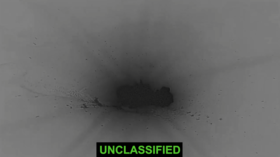Good vibrations? Nanomotion 'life detector' to hunt for extraterrestrial movement

A super-sensitive 'life detector' that uses a nano-sized cantilever to spot motion has arrived. Worth less than $10,000, it could prove especially effective in space exploration probes like the Mars rover, helping discover alien life on other planets.
Researchers at the Swiss Federal Institute of Technology in
Lausanne (EPFL) say they are "calling ESA [European Space
Agency] and NASA to see if they're interested."
A prototype would use very little battery power and could be
contained in a box the size of a book.
If the so called 'life detector' had been available to the ESA's
Philae lander, which detected organic molecules on the surface of
its comet in November, it could have made a real breakthrough
"determining if these conditions are still harboring life, in
any form," Giovanni Longo, the lead author of the paper
published in the Proceedings of the National Academy of Sciences
(PNAS) told AFP in an email.
The key part of the motion detector - the microscopic cantilever
- is basically a beam that is anchored only at one end, with the
other end bearing a load. While the cantilever design is mostly
used with bridges and buildings, this time around it is
implemented on the micrometer scale. About 500 bacteria can be
deposited on it.
"The nanomotion detector allows [for the] studying [of] life from
a new perspective: life is movement," Longo said.
"This means that the nanomotion detector can detect any small
movement of living systems and deliver a complementary point of
view in the search for life," he added.
According to the scientists behind the technology - Giovanni
Dietler, Sandor Kasas and Giovanni Longo - the system has already
proven trustworthy with detecting bacteria, yeast and even cancer
cells, and is currently being considered for the testing of
drugs.

READ MORE: Curiosity for Curiosity! UFO hunter spots ‘coffin’ on Mars (VIDEO)
EPFL scientists say their simple, but "extremely sensitive"
device can be built by adapting already-existing technology. The
idea was inspired by the technology behind the atomic force
microscope, a powerful machine which uses a cantilever to produce
pictures of the very atoms on a surface. The cantilever scans the
surface like the needle of a record player, while its movement is
read by a laser to produce an image.
The motion sensor that the EPFL scientists have engineered works
in a similar way, one difference is that the sample has to be
attached on the cantilever itself.
For example, the scientists say, a bacterium attaches to the
cantilever. If it's alive, it will inevitably produce some sort
of movement. That motion will also move the cantilever and will
be captured by the readout laser as a series of vibrations. The
signal will be taken as a sign of life.
The EPFL scientists say they have successfully tested their
innovation with isolated bacteria, yeast, and mouse and human
cells. The cantilevers could be covered with bacteria or cancer
cells and incubated with various drug compounds.
If the drugs are effective against the attached cells, the motion
signals will reduce or cease altogether as the cells die off.
According to the scientists, their new approach would be much
quicker than current systems used in by pharmaceutical companies
when looking for candidate antibiotics or anticancer drugs.
"The system has the benefit of being completely
chemistry-free," Dietler says. "That means that it can
be used anywhere - in drug testing or even in the search for
extraterrestrial life."
"This is really the next step," Dietler believes.












